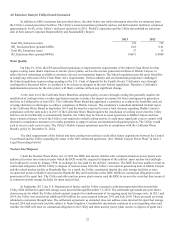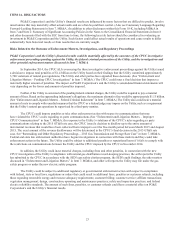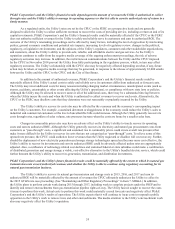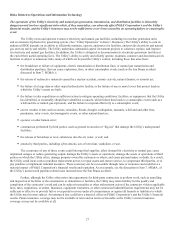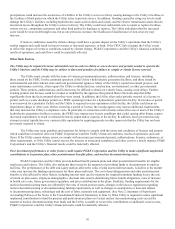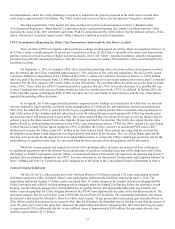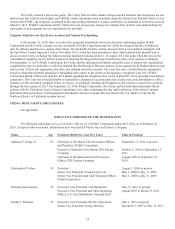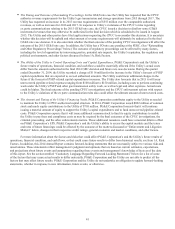PG&E 2014 Annual Report Download - page 40
Download and view the complete annual report
Please find page 40 of the 2014 PG&E annual report below. You can navigate through the pages in the report by either clicking on the pages listed below, or by using the keyword search tool below to find specific information within the annual report.32
ITEM 1B. UNRESOLVED STAFF COMMENTS
None.
ITEM 2. PROPERTIES
The Utility owns or has obtained the right to occupy and/or use real property comprising the Utility’s electricity
and natural gas distribution facilities, natural gas gathering facilities and generation facilities, and natural gas and electricity
transmission facilities, which are described in Item 1. Business, under “Electric Utility Operations” and “Natural Gas Utility
Operations.” The Utility occupies or uses real property that it does not own primarily through various leases, easements, rights-
of-way, permits, or licenses from private landowners or governmental authorities. In total, the Utility occupies 11.2 million
square feet of real property, including 8.8 million square feet owned by the Utility. The Utility’s corporate headquarters comprises
approximately 1.7 million square feet located in several Utility-owned buildings in San Francisco, California.
PG&E Corporation also leases approximately 42,000 square feet of office space from a third party in San Francisco,
California. This lease will expire in 2022.
The Utility currently owns approximately 167,000 acres of land, including approximately 140,000 acres of watershed
lands. In 2002 the Utility agreed to permanently preserve six “beneficial public values” on all its watershed lands through
conservation easements or equivalent protections, and to make up to 44,000 acres of its watershed lands available for donation to
public entities or qualified non-profit conservation organizations. The six “beneficial public values” being preserved through these
conservation easements include: natural habitat of fish, wildlife, and plants; open space; outdoor recreation by the general public;
sustainable forestry; agricultural uses; and historic values. The Pacific Forest Watershed Lands Stewardship Council oversees the
implementation of a land conservation plan that articulates the long-term management objectives for these watershed lands. The
Utility’s goal is to implement all the transactions needed to implement the land conservation plan by the end of 2017, subject to
securing all required regulatory approvals.
ITEM 3. LEGAL PROCEEDINGS
In addition to the following proceedings, PG&E Corporation and the Utility are parties to various lawsuits and regulatory
proceedings in the ordinary course of their business. For more information regarding material lawsuits and proceedings, see
“Enforcement and Litigation Matters” in Note 14 of the Notes to the Consolidated Financial Statements in Item 8 and in Item 7.
MD&A.
Diablo Canyon Power Plant
The Utility’s Diablo Canyon power plant employs a “once-through” cooling water system that is regulated under a Clean
Water Act permit issued by the Central Coast Board. This permit allows the Diablo Canyon power plant to discharge the cooling
water at a temperature no more than 22 degrees above the temperature of the ambient receiving water, and requires that the
beneficial uses of the water be protected. The beneficial uses of water in this region include industrial water supply, marine and
wildlife habitat, shellfish harvesting, and preservation of rare and endangered species. In January 2000, the Central Coast Board
issued a proposed draft cease and desist order alleging that, although the temperature limit has never been exceeded, the Utility’s
Diablo Canyon power plant’s discharge was not protective of beneficial uses.
In October 2000, the Utility and the Central Coast Board reached a tentative settlement under which the Central Coast
Board agreed to find that the Utility’s discharge of cooling water from the Diablo Canyon power plant protects beneficial uses and
that the intake technology reflects the best technology available, as defined in the federal Clean Water Act. As part of the tentative
settlement, the Utility agreed to take measures to preserve certain acreage north of the plant and to fund approximately $6 million
in environmental projects and future environmental monitoring related to coastal resources. On March 21, 2003, the Central Coast
Board voted to accept the settlement agreement. On June 17, 2003, the settlement agreement was executed by the Utility, the
Central Coast Board and the California Attorney General’s Office. A condition to the effectiveness of the settlement agreement is
that the Central Coast Board renew Diablo Canyon’s permit.
At its July 10, 2003 meeting, the Central Coast Board did not renew the permit and continued the permit renewal hearing
indefinitely. Several Central Coast Board members indicated that they no longer supported the settlement agreement, and the
Central Coast Board requested a team of independent scientists, as part of a technical working group, to develop additional
information on possible mitigation measures for Central Coast Board staff. In January 2005, the Central Coast Board published
the scientists’ draft report recommending several such mitigation measures. If the Central Coast Board adopts the scientists’


